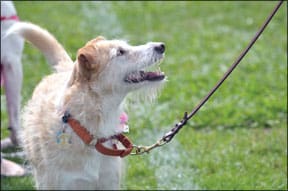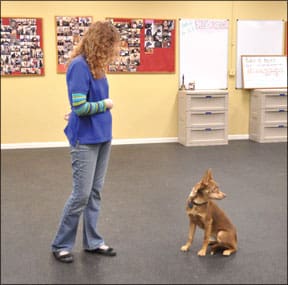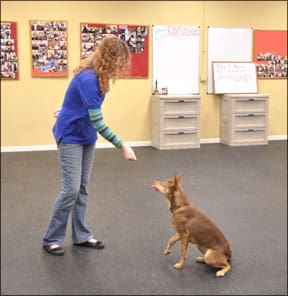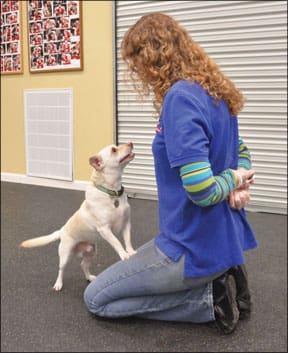[Updated December 26, 2018]
There’s a new dog coming into your life who needs to learn her name. A puppy perhaps? Or maybe an adult rescue “do-over” dog? You might even have a dog who’s been with you for a while, but just doesn’t respond to her name as promptly as you’d like. If you’re eagerly anticipating the arrival of a new canine family member, be sure to put “teaching the name response” on top of your dog to-do list. And if you’re frustrated that your current dog doesn’t appear to know who she is, don’t fret; it’s never too late to teach this very important behavior.

How to Name Your Dog
We humans develop a personal attachment to our own names at a very early age. I am Pat Miller. Your WDJ editor is Nancy Kerns. Even a young child, when he hears his name, registers a “that’s me!” response. Our dogs, probably not so much. Although we can’t know for sure unless and until some day we can actually get inside their heads, it’s likely that a dog just learns to associate the sound of her name with (we hope) “good stuff” in the same way she associates other things (a ball, a leash, the car keys, the clicker) with good stuff.
Looks can be deceiving. When I say “Lucy!” only our Corgi gets excited. If I call “Scooter!” our Pomeranian does the happy dance. Our Scottie comes running if I call “Dubhy!” while we’re doing barn chores, while the rest of our dogs continue about their business. It sure seems that they know who they are! However, the simplest and most likely explanation, is that each of them, over time, has learned that good stuff happens for them when they hear their name sound, but not the other name sounds. That doesn’t mean they grasp the “I am my name” concept that we humans seem to instinctively understand.

Here is the key to teaching your dog to respond to her name: Name = good stuff. It’s almost as simple as that. While teaching your dog that her name means good stuff, you also need to be careful not to send her a mixed message. If you sometimes use her name to yell at her in anger, she’s likely to stop and weigh her options. “Let’s see… I wonder if a good thing will happen this time, or if a bad thing will happen. Hmmmmm.”
If she has to stop and think about it, it’s too slow. You want that unpoisoned, instantaneous, automatic “Yay! Good stuff!” response when she hears her name-sound. So, as you go forward teaching your new dog her name, be sure to keep it always positive. If you must yell at your dog, do it without using her name. If you think your dog’s name is already poisoned, consider giving her a new one, and then teach her that the new name is the best sound in the world.

Choosing a Good Name Can Improve Your Dog’s Training!
As a child, I was enchanted by TS. Eliot’s The Book of Practical Cats, especially his poem, The Naming of Cats. I had the whole thing memorized at one time, and can still recite parts of it, starting with, “The naming of cats is a difficult
matter — it’s not just one of your everyday games And you may think I’m as mad as a hatter when I tell you a cat must have three different names.”
Eliot may have thought naming cats was difficult, but I think naming dogs is infinitely harder. The wrong name can be a self-fulfilling prophecy of doom, while the right one can steer a dog onto the road to success. “Killer” and “Stupid” are obviously poor name choices, while “Champ” and “Hero” are clear winners. Dogster.com breaks down dog naming nicely here.

But it’s not always as clear cut as that. The owner who gets a new puppy at Christmas and names her “Noel” or “Snowbird” may realize too late that the unfortunate inclusion of the sound “No” in her dog’s name can create a strong negative name-association rather than the positive one we strive for — especially if it’s an owner who hasn’t fully bought into positive training and uses a strong aversive “No!” reprimand. Check your prospective dog name choices for any negative sounds and toss out any that might have a bad association.
In a multi-dog household, it’s best to avoid redundant name sounds. We made the mistake of naming our Scotty “Dubhy” (pronounced “Duffy”) while Dusty, our aging Pomeranian, was still with us. Although we vowed never to do that again because of the confusion it caused, we currently have a “Missy” and a “Lucy” – close enough that it can also create “mistaken identity” incidents between the two.
Multi-syllabic names are usually shortened to nicknames, so that’s not a problem: “Footloose and Fancy Free” becomes “Lucy,” and “Bonnie Wee Lass” is just Bonnie. Even nicknames are fine – a dog has no problem with happy associations with many different name-sounds. “Lucy” is also “Lulu”; “Dubhy” is “Doodles”; “Bonnie” can be “Bon-Bons”; and “Scooter” is also quite happy to respond to “Scootie Man.”
Clients often ask me about changing a dog’s name. Of course, many shelter and rescue dogs arrive without names. They may be given temporary names by staff and volunteers, but adopters often choose a different name once they get their dogs home – and dogs do just fine with that. Some people spend hours trying out different names to see if the dog responds to any of them, but that’s not necessary. In fact. if you have reason to suspect your new dog may have any kind of negative association with the name he came with – abuse, neglect, or harsh training methods – you are better off changing it.
Like many dog owners, we like to select names for each of our four-legged family members that have some special significance. We had a cat for 18 years named “Gewurztraminer” because that’s the kind of wine we were drinking when we found him. “Dubhy” means “dark” in Gaelic – appropriate for our Scottish dog. My husband, Paul, wanted to name our current Pomeranian “Harley,” because we have great times together on our motorcycle. “But,” I said, “He’s too little to be a Harley. He’s more the size of a scooter.” So “Scooter” he is.
Teaching Dogs the Name Response
Remember that your dog’s name does not mean come. It simply means “Look at me and wait for further instructions.” It’s important to make this distinction. There will be times when you want your dog’s attention but you don’t necessarily want her to come running to you. If she’s on the other side of the room and you want her to lie down there, you might say, “Lucy,” and when she looks at you, say “Down.” The more you aspire to advanced levels of communication and training with your dog, the more important it is that each cue has a very clear and specific meaning.
In order to train your dog you must be able to capture and retain her attention. Teach your dog to respond to her name by associating it with a click (or a verbal marker such as “Yes!”) and a food reward. At first, when your dog is already looking at you, say her name, click, and offer her a treat. Do this several times to create an association between the sound of her name and the resulting click-and-treat.
Teach her to continue to focus on you by clicking and giving her a reward several times, for time periods that gradually increase in length, as she continues to look at you.

You’ll have the most success with this if you start off with a high-value treat. If I wanted you to look at me instantly when I say “Fribbit,” I might say “Fribbit” and hand you a one hundred dollar bill. That would get your attention! If I give you a one hundred dollar bill every time you hear me say “Fribbit,” you’ll probably become pretty consistent about looking at me for “Fribbit.” In time, even if you don’t get a hundred dollars for every “Fribbit,” you’re still going to look, in hopes that this”Fribbit” might be a winner.
Now think about your response if, instead of a hundred dollar bill, I gave you a penny every time I said “Fribbit.” You probably wouldn’t care much, if at all. You’d quickly get bored with pennies and look for something more rewarding and interesting to do. Find your dog’s equivalent of a one hundred dollar bill. It might be dried liver, cheese, anchovies, bits of canned chicken . . . try a variety of foods to find the one that immediately captures your dog’s rapt attention.
You can also use life rewards for teaching the name response. If your dog is a tennis ball nut, say her name, and when she looks, toss her the ball. Life rewards tend to slow down the repetition process (it usually takes longer to deliver repeated life rewards – you have to get the ball back before you can do it again), but if it’s something your dog really loves you can make up for lost repetition time with the enthusiasm of the response and the faster positive-association time.
When you think the association has been established between your dog’s name and the high-value treat, wait until she glances away, then say her name. (You might have to hide the treats behind your back, stop making eye contact, and wait a while to get her to look away.) If she looks back at you right away when you say her name, click and give her a treat.
If she doesn’t look at you immediately, don’t say her name again; instead, make a “kissy noise” (very technical dog training term) to get her to look at you; then click and treat. If you have to make the kissy noise several times in a row as you repeat the exercise, back up and spend more time creating a stronger association between the name and the click-treat while she’s looking at you, before trying again when she looks away.

Adding Distractions to Name Training
When you’re getting a very prompt and consistent “snap” of your dog’s head back to you at the sound of her name, you’re ready to start adding distractions. Start with small distractions at first; you want to set up your dog to succeed, not flunk the first test. Ask a family member to make a small noise on the other side of the room. When your dog glances in that direction, say her name, and when her head snaps back, click and give her a treat.
If she doesn’t look back at you immediately, use your kissy noise to get her to look. When she looks, click and treat. If you have to “kiss” to get her to look several times in a row, go back to working without distractions again for a while, and/or find a higher-value reinforcer.
When you’re getting a reliable snap-back name response with low-level distractions, gradually increase the amount of environmental interference. First, increase distractions in your own home environment with more sound and/or movement of other family members, including four-legged ones, then up the ante by taking the show on the road. Play the name-response game when you’re taking your dog for a walk around the block, hanging out at your son’s soccer game, and playing at the dog park.
If you lose your dog’s response at any step of the process, back up to your last level of success, spend some more time working at that level, then move forward again, perhaps in smaller steps. Eventually you’ll have a rock-solid name response from your dog that, along with reinforcement for increasing length of attention, will serve you both well as you live and learn together for many years to come.
NAMING YOUR DOG: OVERVIEW
1. Consider carefully and choose wisely if you are naming (or renaming) your dog.
2. Commit to giving your dog a very consistent, very positive association with the name you choose. Name = good stuff. Always.
3. Protect that positive association for the rest of your dog’s life so her name never becomes “poisoned” by you or by anyone else who comes in contact with your dog.
Pat Miller, CBCC-KA, CPDT-KA, is WDJ’s Training Editor. Miller lives in Fairplay, Maryland, site of her Peaceable Paws training center. Pat is also author of several books on positive training, including her latest: Do Over Dogs: Give Your Dog a Second Chance for a First Class Life.






